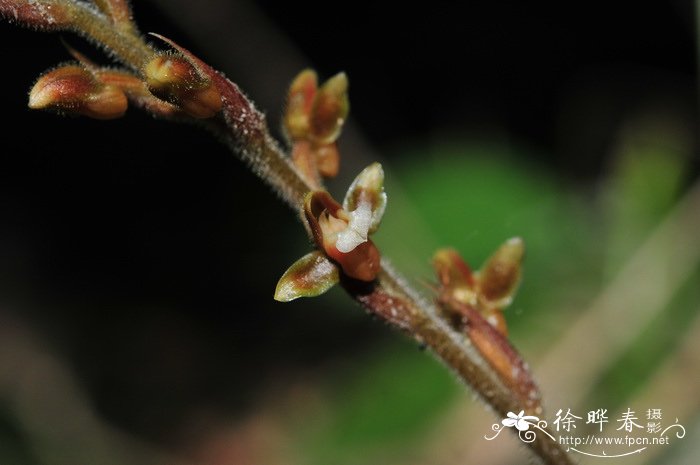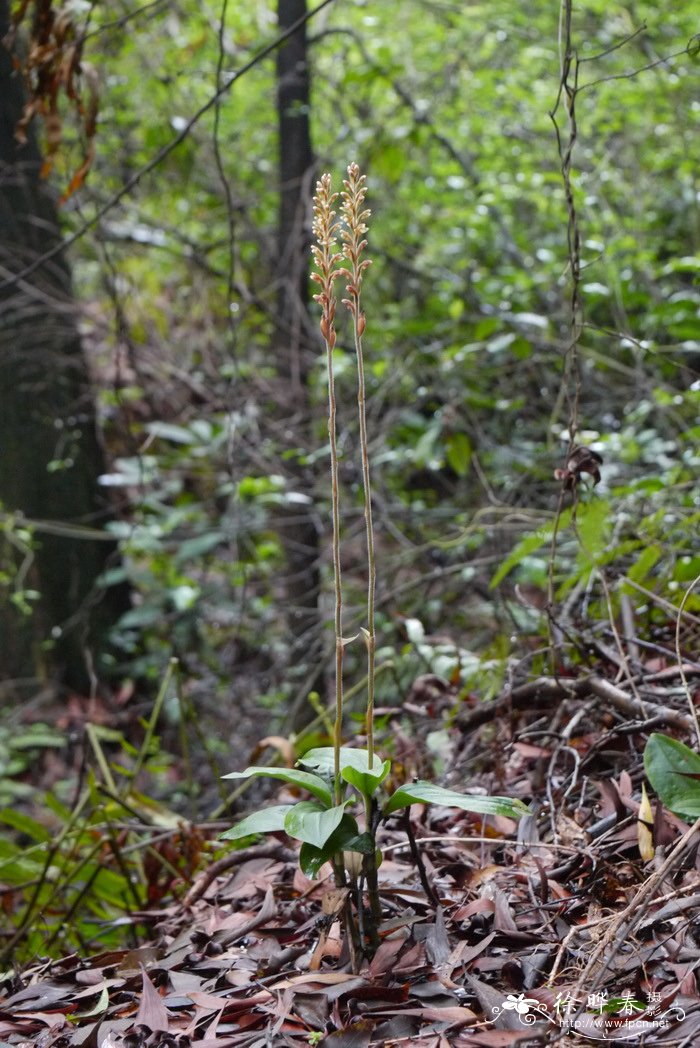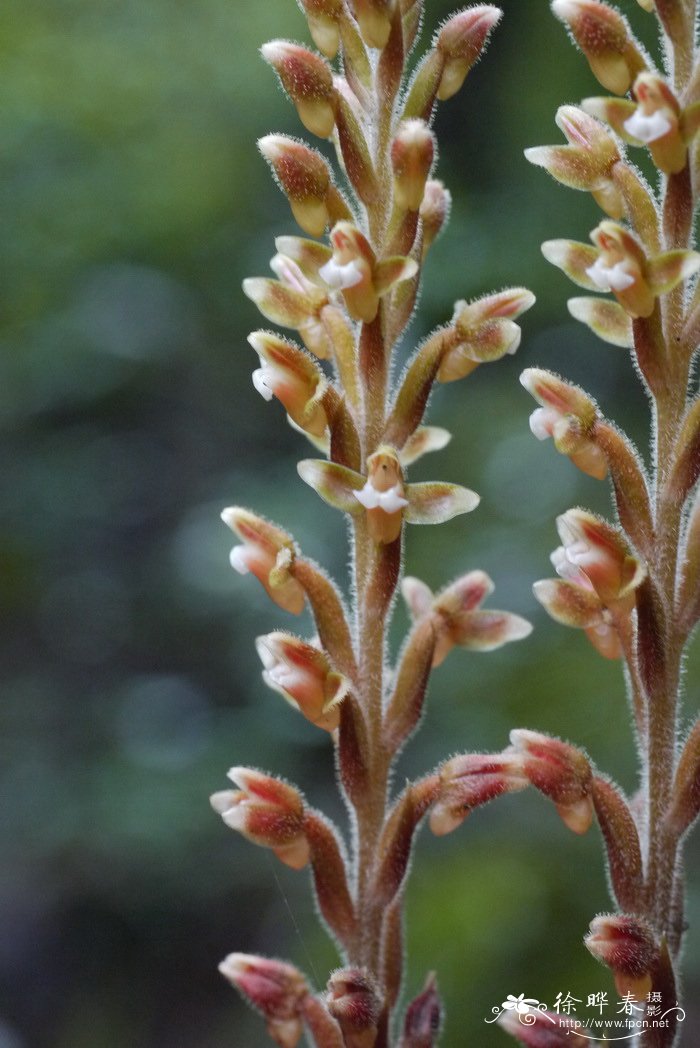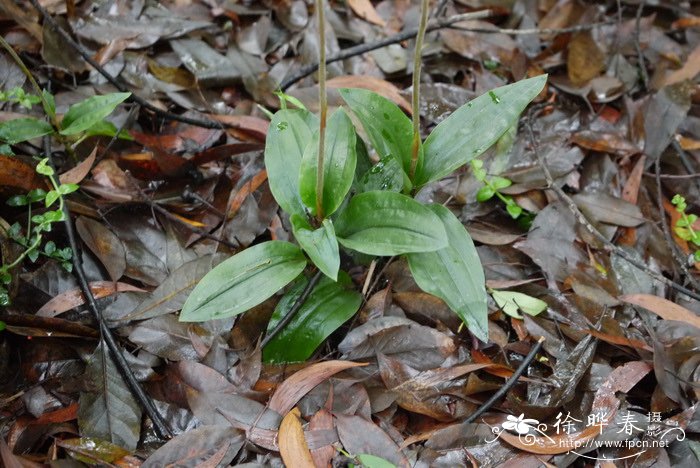钳唇兰 Erythrodes blumei
中文名(Chinese Name):钳唇兰
学名(Scientific Name):Erythrodes blumei (Lindl.) Schltr.
英文名(English Common Name):
别名(Chinese Common Name):
异名(Synonym):Erythrodes chinensis (Rolfe) Schltr. Erythrodes formosana Schltr. Erythrodes henryi Schltr. Physurus chinensis Rolfe Physurus blumei Lindl. Erythrodes latifolia Blume :T. S. Lu et H. J. Su Microchilus blumei (Lindl.) D.Dietr. Erythrodes brevicalcar J.J.Sm.
科属(Family & Genus):兰科(Orchidaceae)钳唇兰属
形态特征(Description):植株高18-60厘米。根状茎伸长,匍匐,具节,节上生根。茎直立,圆柱形,直径2.5-3.5毫米,绿色,下部具3-6枚叶。叶片卵形、椭圆形或卵状披针形,有时稍歪斜,长4.5-10厘米,宽2-6厘米,先端急尖,基部宽楔形或钝圆,上面暗绿色,背面淡绿色,具3条明显的主脉,具柄;叶柄长2.4-4厘米,下部扩大成抱茎的鞘。花茎被短柔毛,长12-40厘米,具3-6枚鞘状苞片;总状花序顶生,具多数密生的花,长5-10厘米;花苞片披针形,带红褐色,长10-12毫米,宽约4毫米,先端渐尖,背面被短柔毛;子房圆柱形,红褐色,扭转,被短柔毛,连花梗长9-10毫米;花较小,萼片带红褐色或褐绿色,背面被短柔毛,中萼片直立,凹陷,长椭圆形,长4-6毫米,宽1.5-2.5毫米,先端稍钝;侧萼片张开,偏斜的椭圆形或卵状椭圆形,长5.5-6毫米,宽3毫米,先端急尖或稍钝;花瓣倒披针形,长4-6毫米,宽1.5-2毫米,先端钝,与萼片同色,中央具1枚透明的脉,与中萼片粘合呈兜状;唇瓣基部具距,前部3裂,侧裂片直立而小,中裂反折,宽卵形或三角状卵形,白色,先端近急尖;距下垂,近圆筒状,长1.5-4毫米,中部稍膨大,末端2浅裂,内面无毛和无胼胝体,唇瓣的腹面(上面)和距均为带红褐色;蕊柱粗短,直立,长1.5-3毫米,前面无附属物;蕊喙直立,叉状2裂。花期4-5月。
分布(Distribution):产台湾、广东、广西、云南;生于海拔400~1500米的山坡或沟谷常绿阔叶林下阴处。斯里兰卡、印度、缅甸、越南、泰国也有。
用途(Use):
引自中国植物志英文版:FOC Vol. 25 Page 56, 57
Erythrodes blumei (Lindley) Schlechter in Schumann & Lauterbach, Nachtr. Fl. Schutzgeb. Südsee. 87. 1905.
钳唇兰 qian chun lan| Orchidaceae | Erythrodes
Physurus blumei Lindley, Gen. Sp. Orchid. Pl. 504. 1840; Erythrodes brevicalcar J. J. Smith; E. chinensis (Rolfe) Schlechter; E. formosana Schlechter; E. henryi Schlechter; E. triantherae C. L. Yeh & C. S. Leou; Microchilus blumei (Lindley) D. Dietrich; P. chinensis Rolfe; P. henryi (Schlechter) K. Schumann & Lauterbach.
Plants 18-60 cm tall. Stem erect, green, 2.5-3.5 mm in diam., with 3-6 leaves. Leaves petiolate, abaxially pale green, adaxially dark green, ovate, elliptic, or ovate-lanceolate, sometimes slightly oblique, 4.5-10 × 2-6 cm, abaxially with 3 conspicuous veins, base broadly cuneate or obtuse, apex acute; petiole 2.4-4 cm, basally dilated into amplexicaul sheath. Peduncle 12-40 cm, pubescent, with 3-6 sterile bracts; rachis 5-10 cm, pubescent, subdensely many flowered; floral bracts reddish brown, lanceolate, 10-12 × ca. 4 mm, abaxially pubescent, apex acuminate. Flowers small; sepals pubescent outside, reddish brown or brownish green outside, white with pinkish markings inside; ovary reddish brown, twisted, terete, pubescent, including pedicel 9-10 mm. Dorsal sepal erect, concave, narrowly elliptic, 4-6 × 1.5-2.5 mm, apex slightly obtuse; lateral sepals spreading, obliquely elliptic or ovate-elliptic, 5.5-6 × ca. 3 mm, apex acute or slightly obtuse. Petals similar in color to sepals, oblanceolate, 4-6 × 1.5-2 mm, midvein transparent, apex obtuse; lip reddish brown adaxially, 4-5.5 mm, 3-lobed at apex; lateral lobes erect, small; mid-lobe reflexed, white, broadly ovate to triangular-ovate, apex subacute; spur pendulous, reddish brown, tubular, 1.5-4 mm, centrally slightly dilated, glabrous, apex shallowly 2-lobed. Column erect, 1.5-4 mm, bearing up to 3 anthers in some Taiwanese populations. Fl. Apr-May.
Evergreen broad-leaved forests; 400-1500 m. Guangdong, Guangxi, Taiwan, SE Yunnan [NE India, Indonesia, Malaysia, N Myanmar, Thailand, Vietnam].
Continuity in the length of the spur and in the outline of the central lobe of the lip make it difficult to distinguish between Erythrodes chinensis and E. blumei, though Ormerod (Lindleyana 17: 194. 2002) used these characters to differentiate the two. The report of E. latifolia Blume from Taiwan (in T. S. Liu & H. J. Su, Fl. Taiwan 5: 990. 1978) is considered a misidentification of E. blumei. The recently described E. triantherae from Taiwan, which the authors distinguished from E. blumei primarily by the presence of up to three anthers on the column (see C. L. Yeh & C. S. Leou, Taiwania 51: 266. 2006), is probably a peloric mutant and is referable to E. blumei when the full range in dimensions of other floral parts in the latter is taken into account.



 (责任编辑:徐晔春)
(责任编辑:徐晔春)
学名(Scientific Name):Erythrodes blumei (Lindl.) Schltr.
英文名(English Common Name):
别名(Chinese Common Name):
异名(Synonym):Erythrodes chinensis (Rolfe) Schltr. Erythrodes formosana Schltr. Erythrodes henryi Schltr. Physurus chinensis Rolfe Physurus blumei Lindl. Erythrodes latifolia Blume :T. S. Lu et H. J. Su Microchilus blumei (Lindl.) D.Dietr. Erythrodes brevicalcar J.J.Sm.
科属(Family & Genus):兰科(Orchidaceae)钳唇兰属
形态特征(Description):植株高18-60厘米。根状茎伸长,匍匐,具节,节上生根。茎直立,圆柱形,直径2.5-3.5毫米,绿色,下部具3-6枚叶。叶片卵形、椭圆形或卵状披针形,有时稍歪斜,长4.5-10厘米,宽2-6厘米,先端急尖,基部宽楔形或钝圆,上面暗绿色,背面淡绿色,具3条明显的主脉,具柄;叶柄长2.4-4厘米,下部扩大成抱茎的鞘。花茎被短柔毛,长12-40厘米,具3-6枚鞘状苞片;总状花序顶生,具多数密生的花,长5-10厘米;花苞片披针形,带红褐色,长10-12毫米,宽约4毫米,先端渐尖,背面被短柔毛;子房圆柱形,红褐色,扭转,被短柔毛,连花梗长9-10毫米;花较小,萼片带红褐色或褐绿色,背面被短柔毛,中萼片直立,凹陷,长椭圆形,长4-6毫米,宽1.5-2.5毫米,先端稍钝;侧萼片张开,偏斜的椭圆形或卵状椭圆形,长5.5-6毫米,宽3毫米,先端急尖或稍钝;花瓣倒披针形,长4-6毫米,宽1.5-2毫米,先端钝,与萼片同色,中央具1枚透明的脉,与中萼片粘合呈兜状;唇瓣基部具距,前部3裂,侧裂片直立而小,中裂反折,宽卵形或三角状卵形,白色,先端近急尖;距下垂,近圆筒状,长1.5-4毫米,中部稍膨大,末端2浅裂,内面无毛和无胼胝体,唇瓣的腹面(上面)和距均为带红褐色;蕊柱粗短,直立,长1.5-3毫米,前面无附属物;蕊喙直立,叉状2裂。花期4-5月。
分布(Distribution):产台湾、广东、广西、云南;生于海拔400~1500米的山坡或沟谷常绿阔叶林下阴处。斯里兰卡、印度、缅甸、越南、泰国也有。
用途(Use):
引自中国植物志英文版:FOC Vol. 25 Page 56, 57
Erythrodes blumei (Lindley) Schlechter in Schumann & Lauterbach, Nachtr. Fl. Schutzgeb. Südsee. 87. 1905.
钳唇兰 qian chun lan| Orchidaceae | Erythrodes
Physurus blumei Lindley, Gen. Sp. Orchid. Pl. 504. 1840; Erythrodes brevicalcar J. J. Smith; E. chinensis (Rolfe) Schlechter; E. formosana Schlechter; E. henryi Schlechter; E. triantherae C. L. Yeh & C. S. Leou; Microchilus blumei (Lindley) D. Dietrich; P. chinensis Rolfe; P. henryi (Schlechter) K. Schumann & Lauterbach.
Plants 18-60 cm tall. Stem erect, green, 2.5-3.5 mm in diam., with 3-6 leaves. Leaves petiolate, abaxially pale green, adaxially dark green, ovate, elliptic, or ovate-lanceolate, sometimes slightly oblique, 4.5-10 × 2-6 cm, abaxially with 3 conspicuous veins, base broadly cuneate or obtuse, apex acute; petiole 2.4-4 cm, basally dilated into amplexicaul sheath. Peduncle 12-40 cm, pubescent, with 3-6 sterile bracts; rachis 5-10 cm, pubescent, subdensely many flowered; floral bracts reddish brown, lanceolate, 10-12 × ca. 4 mm, abaxially pubescent, apex acuminate. Flowers small; sepals pubescent outside, reddish brown or brownish green outside, white with pinkish markings inside; ovary reddish brown, twisted, terete, pubescent, including pedicel 9-10 mm. Dorsal sepal erect, concave, narrowly elliptic, 4-6 × 1.5-2.5 mm, apex slightly obtuse; lateral sepals spreading, obliquely elliptic or ovate-elliptic, 5.5-6 × ca. 3 mm, apex acute or slightly obtuse. Petals similar in color to sepals, oblanceolate, 4-6 × 1.5-2 mm, midvein transparent, apex obtuse; lip reddish brown adaxially, 4-5.5 mm, 3-lobed at apex; lateral lobes erect, small; mid-lobe reflexed, white, broadly ovate to triangular-ovate, apex subacute; spur pendulous, reddish brown, tubular, 1.5-4 mm, centrally slightly dilated, glabrous, apex shallowly 2-lobed. Column erect, 1.5-4 mm, bearing up to 3 anthers in some Taiwanese populations. Fl. Apr-May.
Evergreen broad-leaved forests; 400-1500 m. Guangdong, Guangxi, Taiwan, SE Yunnan [NE India, Indonesia, Malaysia, N Myanmar, Thailand, Vietnam].
Continuity in the length of the spur and in the outline of the central lobe of the lip make it difficult to distinguish between Erythrodes chinensis and E. blumei, though Ormerod (Lindleyana 17: 194. 2002) used these characters to differentiate the two. The report of E. latifolia Blume from Taiwan (in T. S. Liu & H. J. Su, Fl. Taiwan 5: 990. 1978) is considered a misidentification of E. blumei. The recently described E. triantherae from Taiwan, which the authors distinguished from E. blumei primarily by the presence of up to three anthers on the column (see C. L. Yeh & C. S. Leou, Taiwania 51: 266. 2006), is probably a peloric mutant and is referable to E. blumei when the full range in dimensions of other floral parts in the latter is taken into account.
踩一下[2]

顶一下[4]